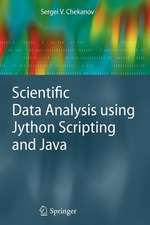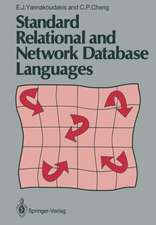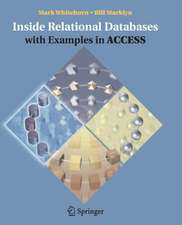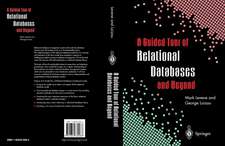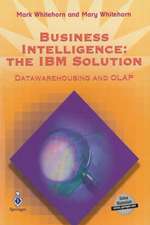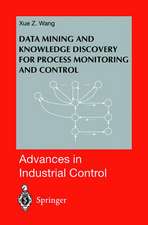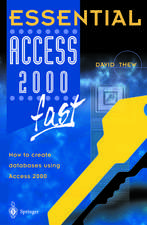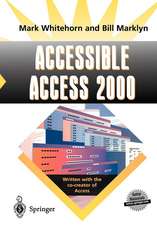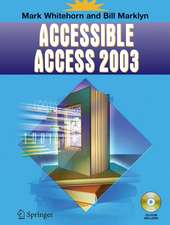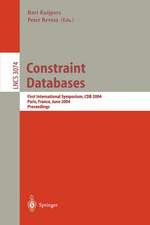Introduction to Databases: From Biological to Spatio-Temporal: Texts in Computer Science
Autor Peter Reveszen Limba Engleză Paperback – 14 mar 2012
| Toate formatele și edițiile | Preț | Express |
|---|---|---|
| Paperback (1) | 743.62 lei 6-8 săpt. | |
| SPRINGER LONDON – 14 mar 2012 | 743.62 lei 6-8 săpt. | |
| Hardback (1) | 702.64 lei 38-44 zile | |
| SPRINGER LONDON – 11 ian 2010 | 702.64 lei 38-44 zile |
Din seria Texts in Computer Science
- 17%
 Preț: 366.69 lei
Preț: 366.69 lei - 20%
 Preț: 675.35 lei
Preț: 675.35 lei - 20%
 Preț: 370.59 lei
Preț: 370.59 lei - 20%
 Preț: 411.75 lei
Preț: 411.75 lei - 20%
 Preț: 306.35 lei
Preț: 306.35 lei - 20%
 Preț: 474.58 lei
Preț: 474.58 lei - 20%
 Preț: 1244.39 lei
Preț: 1244.39 lei - 20%
 Preț: 409.70 lei
Preț: 409.70 lei - 20%
 Preț: 379.63 lei
Preț: 379.63 lei - 20%
 Preț: 444.93 lei
Preț: 444.93 lei - 20%
 Preț: 305.30 lei
Preț: 305.30 lei - 20%
 Preț: 406.21 lei
Preț: 406.21 lei - 20%
 Preț: 460.78 lei
Preț: 460.78 lei - 20%
 Preț: 503.87 lei
Preț: 503.87 lei - 20%
 Preț: 370.22 lei
Preț: 370.22 lei - 20%
 Preț: 411.53 lei
Preț: 411.53 lei - 20%
 Preț: 423.52 lei
Preț: 423.52 lei - 20%
 Preț: 441.70 lei
Preț: 441.70 lei - 20%
 Preț: 515.34 lei
Preț: 515.34 lei - 15%
 Preț: 637.58 lei
Preț: 637.58 lei - 20%
 Preț: 353.33 lei
Preț: 353.33 lei - 20%
 Preț: 356.82 lei
Preț: 356.82 lei - 20%
 Preț: 181.92 lei
Preț: 181.92 lei - 20%
 Preț: 330.42 lei
Preț: 330.42 lei - 20%
 Preț: 663.45 lei
Preț: 663.45 lei -
 Preț: 457.75 lei
Preț: 457.75 lei - 20%
 Preț: 536.66 lei
Preț: 536.66 lei - 20%
 Preț: 358.24 lei
Preț: 358.24 lei -
 Preț: 385.84 lei
Preț: 385.84 lei - 20%
 Preț: 394.57 lei
Preț: 394.57 lei - 20%
 Preț: 344.76 lei
Preț: 344.76 lei - 20%
 Preț: 621.18 lei
Preț: 621.18 lei - 20%
 Preț: 350.86 lei
Preț: 350.86 lei - 20%
 Preț: 348.89 lei
Preț: 348.89 lei - 20%
 Preț: 339.95 lei
Preț: 339.95 lei - 20%
 Preț: 588.21 lei
Preț: 588.21 lei - 20%
 Preț: 199.57 lei
Preț: 199.57 lei - 20%
 Preț: 341.30 lei
Preț: 341.30 lei - 23%
 Preț: 726.93 lei
Preț: 726.93 lei - 20%
 Preț: 325.30 lei
Preț: 325.30 lei - 20%
 Preț: 595.80 lei
Preț: 595.80 lei - 20%
 Preț: 593.48 lei
Preț: 593.48 lei -
 Preț: 454.30 lei
Preț: 454.30 lei
Preț: 743.62 lei
Preț vechi: 929.52 lei
-20% Nou
Puncte Express: 1115
Preț estimativ în valută:
142.29€ • 148.56$ • 117.76£
142.29€ • 148.56$ • 117.76£
Carte tipărită la comandă
Livrare economică 05-19 aprilie
Preluare comenzi: 021 569.72.76
Specificații
ISBN-13: 9781447125334
ISBN-10: 1447125339
Pagini: 772
Ilustrații: XVII, 743 p.
Dimensiuni: 210 x 279 x 41 mm
Greutate: 1.71 kg
Ediția:2010
Editura: SPRINGER LONDON
Colecția Springer
Seria Texts in Computer Science
Locul publicării:London, United Kingdom
ISBN-10: 1447125339
Pagini: 772
Ilustrații: XVII, 743 p.
Dimensiuni: 210 x 279 x 41 mm
Greutate: 1.71 kg
Ediția:2010
Editura: SPRINGER LONDON
Colecția Springer
Seria Texts in Computer Science
Locul publicării:London, United Kingdom
Public țintă
Professional/practitionerCuprins
Data Models, Queries, Evaluation.- Propositional Databases.- Relational Databases.- Constraint Databases.- Temporal Databases.- Geographic Databases.- Moving Objects Databases.- Image Databases.- Constraint Objects Databases.- Genome Databases.- Set Databases.- Constraint Deductive Databases.- The MLPQ System.- The DISCO System.- Database Design.- Interoperability.- Data Integration.- Interpolation and Approximation.- Prediction and Data Mining.- Indexing.- Data Visualization.- Safe Query Languages.- Evaluation of Queries.- Implementation Methods.- Computational Complexity.- Software Verification.
Recenzii
From the reviews:
“Offers an introduction to modern databases. … In this well-organized book, the presentation is simple and easy to understand. As a result, students will find this introductory textbook useful. Furthermore, they will benefit from its numerous illustrative examples, exercises, and bibliographic notes. … The book offers an interesting perspective into the many specialized databases that are currently in existence--something virtually no other book on the market offers. … In short, I strongly recommend it to readers who are interested in databases.” (S. V. Nagaraj, ACM Computing Reviews, February, 2011)
“A book that covers all the modern turns and directions that databases have taken in recent years. … Overall, this is a very valuable addition to the database textbook literature. The author claims that the primary audience for this book are undergraduates, but I believe that it can and will reach beyond that level of database education.” (Gottfried Vossen,Zentralblatt MATH, Vol. 1191, 2010)
“Offers an introduction to modern databases. … In this well-organized book, the presentation is simple and easy to understand. As a result, students will find this introductory textbook useful. Furthermore, they will benefit from its numerous illustrative examples, exercises, and bibliographic notes. … The book offers an interesting perspective into the many specialized databases that are currently in existence--something virtually no other book on the market offers. … In short, I strongly recommend it to readers who are interested in databases.” (S. V. Nagaraj, ACM Computing Reviews, February, 2011)
“A book that covers all the modern turns and directions that databases have taken in recent years. … Overall, this is a very valuable addition to the database textbook literature. The author claims that the primary audience for this book are undergraduates, but I believe that it can and will reach beyond that level of database education.” (Gottfried Vossen,Zentralblatt MATH, Vol. 1191, 2010)
Textul de pe ultima copertă
Developments in modern computers and applications have resulted in a shift away from relational databases into a chaotic proliferation of specialized database systems. As many of these advanced databases are unable to communicate with each other, database interoperability and data integration have become important challenges. The search for a suitable common standard for the numerous varieties of current databases has generated renewed interest in extensions of relational databases, such as constraint databases.
This unique, reader-friendly textbook/reference provides a comprehensive coverage of the field of databases. Introduction to Databases reveals a deep insight into the workings of numerous database systems, enabling readers to develop complex and rewarding database applications. Students will gain hands-on experience by following the suggested exercises, and are offered the support to begin their own research projects in database systems. The theory covered is complemented by a detailed examination of specific applications from a broad range of diverse areas. The text assumes as prerequisite only basic discrete mathematics, linear algebra, and programming knowledge.
Topics and features:
• Provides chapter-by-chapter descriptions of eleven different types of databases, and presents the MLPQ and the DISCO database systems that implement several different types of databases
• Concludes each chapter with bibliographic notes and an extensive set of exercises
• Examines database design, including advanced database application issues of database interoperability, data integration, interpolation and approximation, and prediction and data mining
• Presents the MLPQ system, together with slides, solutions (for instructors), and other course aids at the supporting website: http://cse.unl.edu/~revesz
• Covers topics on indexing methods, data visualization, the safety of queries, general evaluation algorithms, the efficient implementation of evaluation algorithms, and the complexity of the evaluation of different types of queries
• Structured to allow for flexible course design, with courses suggested in the Preface
An essential resource for advanced undergraduate students, even non-computer science students with little prior exposure to databases will find this a clear introduction to the theory, the various types of databases and their applications. Professional database experts will also find this a valuable reference.
Dr. Peter Revesz is a professor in the Department of Computer Science and Engineering at the University of Nebraska-Lincoln and has held visiting appointments at, among other places, the IBM T.J. Watson Research Center, INRIA, and the Max Planck Institute for Computer Science. Other titles by this author include the successful Springer textbook Introduction toConstraint Databases.
This unique, reader-friendly textbook/reference provides a comprehensive coverage of the field of databases. Introduction to Databases reveals a deep insight into the workings of numerous database systems, enabling readers to develop complex and rewarding database applications. Students will gain hands-on experience by following the suggested exercises, and are offered the support to begin their own research projects in database systems. The theory covered is complemented by a detailed examination of specific applications from a broad range of diverse areas. The text assumes as prerequisite only basic discrete mathematics, linear algebra, and programming knowledge.
Topics and features:
• Provides chapter-by-chapter descriptions of eleven different types of databases, and presents the MLPQ and the DISCO database systems that implement several different types of databases
• Concludes each chapter with bibliographic notes and an extensive set of exercises
• Examines database design, including advanced database application issues of database interoperability, data integration, interpolation and approximation, and prediction and data mining
• Presents the MLPQ system, together with slides, solutions (for instructors), and other course aids at the supporting website: http://cse.unl.edu/~revesz
• Covers topics on indexing methods, data visualization, the safety of queries, general evaluation algorithms, the efficient implementation of evaluation algorithms, and the complexity of the evaluation of different types of queries
• Structured to allow for flexible course design, with courses suggested in the Preface
An essential resource for advanced undergraduate students, even non-computer science students with little prior exposure to databases will find this a clear introduction to the theory, the various types of databases and their applications. Professional database experts will also find this a valuable reference.
Dr. Peter Revesz is a professor in the Department of Computer Science and Engineering at the University of Nebraska-Lincoln and has held visiting appointments at, among other places, the IBM T.J. Watson Research Center, INRIA, and the Max Planck Institute for Computer Science. Other titles by this author include the successful Springer textbook Introduction toConstraint Databases.
Caracteristici
Provides a comprehensive coverage of the field of databases



